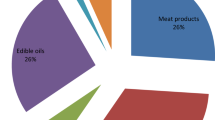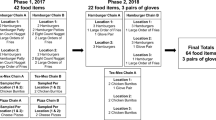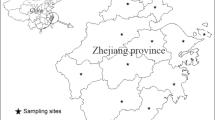Abstract
Three types of popular vendors, including meat and non-meat food (e.g, fishballs), vendor group (I), rice sausage sandwiches vendor group (II), and roasted corn on-the-cob vendor group (III), from the night markets of Taiwan were chosen for this research. The average concentrations of carcinogenic polycyclic aromatic hydrocarbons (car-PAHs) were 2445 ng/m3 for vendor (II), 2276 ng/m3 for vendor (II), and 133 ng/m3 for vendor (III). Vendors groups (I) and (II) had exposure levels of Benzo(a)pyrene (BaP)-equivalent doses (BaPeq) approximately 16 and 13 times higher than those for vendor group (III). The daily exposure doses of BaPeq in working duration for vendor group (II) and (II) were 2.80 and 2.28 μg/day, respectively. The employees of five offices on campus were chosen as a control group. The daily exposure doses of BaPeq during working hours for vendor group (II) and (II) were about 22 times and 18 times, respectively, higher than those for control group. This exposure dose for vendors group (III) (0.18 μg/day) was comparable with the dose for control group (0.13 μg/day). The whole-day exposure doses of t-PAHs, car-PAHs, BaP, and BaPeq for vendor groups (I) and (II) were very close to those during daily working hours. However, the daily exposure doses of BaPeq during working hours for vendor group (III) occurred only in a proportion of 62% of the whole-day exposure doses.
This is a preview of subscription content, access via your institution
Access options
Subscribe to this journal
Receive 6 print issues and online access
$259.00 per year
only $43.17 per issue
Buy this article
- Purchase on Springer Link
- Instant access to full article PDF
Prices may be subject to local taxes which are calculated during checkout
Similar content being viewed by others
Abbreviations
- PAHs:
-
polycyclic aromatic hydrocarbons
- BaP:
-
Benzo(a)pyrene
- BaPeq:
-
BaP-equivalent doses
- car-PAHs:
-
carcinogenic PAHs
- PM10:
-
atmospheric aerosols with diameters <^10 μm
References
Anderson KE, Sinha R, Kulldorff M, Gross M, Lang N, Barber C, Harnack L, DiMagno E, Bliss R, and Kadlubar FF Meat intake and cooking techniques: associations with pancreatic cancer. Mutat Res 2002: 506–507: 225–231.
Chuang JC, Cao SR, Xian YL, Harris DB, and Mumford JL Chemical characterization of indoor air of homes from communes in Xuan Wei, China, with high lung cancer mortality rate. Atmos Environ 1992: 26: 2193–2201.
Dyremark A, Westerholm R, Overvik E, and Gustavsson JA Polycyclic aromatic hydrocarbons (PAHs) emissions from charcoal grilling. Atmos Environ 1995: 29: 1553–1558.
Fretheim K Carcinogenic polycyclic aromatic hydrocarbons in Norwegian smoked meat sausages. J Agricul Food Chem 1976: 24: 976–979.
Gomaa EA, Gray JI, Rabie S, Lopez-Bote C, and Booren AM Polycyclic aromatic hydrocarbons in smoked food products and commercial liquid smoke flavourings. Food Addit Contam 1993: 10: 503–521.
Integrated Risk Information System (IRIS). US Environmental Protection Agency. National Center for Environmental Assessment, Cincinnati, OH, 2001.
Knecht U, and Woitowitz HJ Gaseous and adsorbed PAH in an iron foundry. Br J Ind Med 1986: 43: 834–838.
Kuo CY, Hsu YW, and Lee HS Study of human exposure to particulate PAHs using personal air samplers. Arch Environ Contam Toxicol 2003: 44: 454–459.
Li CT, Lin YC, Lee WJ, and Tasi PJ Emission of polycyclic aromatic hydrocarbons and their carcinogenic potencies from cooking sources to the urban atmosphere. Environ Health Persp 2003: 111: 483–487.
Lung SCC, Guo KJ, Chen PY, Tsai PF, and Chen PC Participants' exposure to PM2 . 5 and gaseous/particulate polycyclic aromatic hydrocarbons during the Ma-tsu Goddess parade. J Expos Anal Environ Epidemiol 2004: 14: 536–543.
Mastral AM, Callen MS, and Garcia T Toxic organic emissions from coal combustion. Fuel Process Technol 2000: 67: 1–10.
Moret S, and Conte LS Polycyclic aromatic hydrocarbons in edible fats and oils: occurrence and analytical methods. J Chromatogr 2000: 882: 245–253.
Mumford JL, Harris DB, Wilson WE, Chapman RS, Cao S, Xian Y, Li X, Chuang JC, and Cooke WM Lung cancer and indoor air pollution in Xuan Wei, China. Science 1987: 235: 217–220.
Nisbet IC, and LaGoy PK Toxic equivalency factors (TEFs) for polycyclic aromatic hydrocarbons (PAHs). Regul Toxicol Pharmocol 1992: 16: 290–300.
Petry T, Schmid P, and Schlatter C The use of toxic equivalency factors in assessing occupational and environmental health risk associated with exposure to airborne mixtures of polycyclic aromatic hydrocarbons (PAHs). Chemosphere 1996: 32: 639–648.
Phillips DH Polycyclic aromatic hydrocarbons in the diet. Mutat Res 1999: 443: 139–147.
Pott FP PAH und lungenkrebrisiko-daten und bewertung. Staub-Reinhaltung dedr Luft 1985: 45: 368–379.
Promvanit N, and Kangsadalampai K Polycyclic aromatic hydrocarbons (PAHs) in some conventional Thai foods by high performance liquid chromatographic technique. Thai J Toxicol 1985: 1: 44–55.
Rogge WF, Hildemann LM, Mazurek MA, and Cass GR Sources of fine organic aerosol. 1. Charbroilers and meat cooking operations. Environ Sci Technol 1991: 25: 1112–1125.
Tsai PJ, Shieh HY, Lee WJ, and Lai SO Health-risk assessment for workers exposed to polycyclic aromatic hydrocarbons (PAHs) in a carbon black manufacturing industry. Sci Total Environ 2001: 278: 137–150.
Tsai PJ, Shih TS, Chen HL, Lee WJ, Lai CH, and Liou SH Assessing and predicting the exposures of polycyclic aromatic hydrocarbons (PAHs) and their carcinogenic potencies from vehicle engine exhausts to highway toll station workers. Atmos Environ 2004: 38: 333–343.
Venkataraman C, Negi G, Sardar SB, and Rastogi R Size distributions of polycyclic aromatic hydrocarbons in aerosol emissions from biofuel combustion. J Aerosol Sci 2002: 33: 503–518.
Author information
Authors and Affiliations
Corresponding author
Rights and permissions
About this article
Cite this article
Kuo, CY., Chang, SH., Chien, YC. et al. Exposure to carcinogenic PAHs for the vendors of broiled food. J Expo Sci Environ Epidemiol 16, 410–416 (2006). https://doi.org/10.1038/sj.jea.7500466
Received:
Revised:
Accepted:
Published:
Issue Date:
DOI: https://doi.org/10.1038/sj.jea.7500466
Keywords
This article is cited by
-
Polyaromatic Hydrocarbons Depositions and Their Carcinogenic Risk Assessment in the Foundry Workers
Aerosol Science and Engineering (2018)



